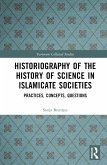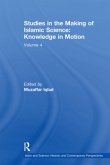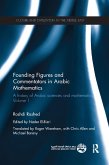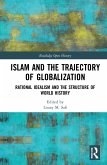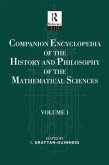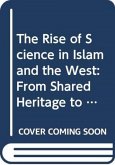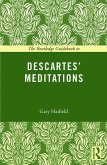Routledge Handbook on the Sciences in Islamicate Societies
Practices from the 2nd/8th to the 13th/19th Centuries
Herausgeber: Brentjes, Sonja
Routledge Handbook on the Sciences in Islamicate Societies
Practices from the 2nd/8th to the 13th/19th Centuries
Herausgeber: Brentjes, Sonja
- Gebundenes Buch
- Merkliste
- Auf die Merkliste
- Bewerten Bewerten
- Teilen
- Produkt teilen
- Produkterinnerung
- Produkterinnerung
This book provides a comprehensive survey on science in the Islamic world from the 8th to the 19th century.
Andere Kunden interessierten sich auch für
![Historiography of the History of Science in Islamicate Societies Historiography of the History of Science in Islamicate Societies]() Sonja BrentjesHistoriography of the History of Science in Islamicate Societies142,99 €
Sonja BrentjesHistoriography of the History of Science in Islamicate Societies142,99 €![Studies in the Making of Islamic Science: Knowledge in Motion Studies in the Making of Islamic Science: Knowledge in Motion]() Studies in the Making of Islamic Science: Knowledge in Motion44,99 €
Studies in the Making of Islamic Science: Knowledge in Motion44,99 €![Founding Figures and Commentators in Arabic Mathematics Founding Figures and Commentators in Arabic Mathematics]() Roshdi RashedFounding Figures and Commentators in Arabic Mathematics46,99 €
Roshdi RashedFounding Figures and Commentators in Arabic Mathematics46,99 €![Islam and the Trajectory of Globalization Islam and the Trajectory of Globalization]() Louay M. SafiIslam and the Trajectory of Globalization64,99 €
Louay M. SafiIslam and the Trajectory of Globalization64,99 €![Companion Encyclopedia of the History and Philosophy of the Mathematical Sciences Companion Encyclopedia of the History and Philosophy of the Mathematical Sciences]() Companion Encyclopedia of the History and Philosophy of the Mathematical Sciences84,99 €
Companion Encyclopedia of the History and Philosophy of the Mathematical Sciences84,99 €![The Rise of Science in Islam and the West The Rise of Science in Islam and the West]() John W. LivingstonThe Rise of Science in Islam and the West44,99 €
John W. LivingstonThe Rise of Science in Islam and the West44,99 €![The Routledge Guidebook to Descartes' Meditations The Routledge Guidebook to Descartes' Meditations]() Gary Hatfield (USA University of Pennsylvania)The Routledge Guidebook to Descartes' Meditations25,99 €
Gary Hatfield (USA University of Pennsylvania)The Routledge Guidebook to Descartes' Meditations25,99 €-
-
-
This book provides a comprehensive survey on science in the Islamic world from the 8th to the 19th century.
Hinweis: Dieser Artikel kann nur an eine deutsche Lieferadresse ausgeliefert werden.
Hinweis: Dieser Artikel kann nur an eine deutsche Lieferadresse ausgeliefert werden.
Produktdetails
- Produktdetails
- Verlag: Taylor & Francis Ltd
- Seitenzahl: 838
- Erscheinungstermin: 24. Januar 2023
- Englisch
- Abmessung: 253mm x 183mm x 52mm
- Gewicht: 1632g
- ISBN-13: 9781138047594
- ISBN-10: 1138047597
- Artikelnr.: 59993434
- Herstellerkennzeichnung
- Libri GmbH
- Europaallee 1
- 36244 Bad Hersfeld
- gpsr@libri.de
- Verlag: Taylor & Francis Ltd
- Seitenzahl: 838
- Erscheinungstermin: 24. Januar 2023
- Englisch
- Abmessung: 253mm x 183mm x 52mm
- Gewicht: 1632g
- ISBN-13: 9781138047594
- ISBN-10: 1138047597
- Artikelnr.: 59993434
- Herstellerkennzeichnung
- Libri GmbH
- Europaallee 1
- 36244 Bad Hersfeld
- gpsr@libri.de
Sonja Brentjes is a historian of science in Islamicate societies and Christian Europe; she is an affiliated scholar at the Max Planck Institute for the History of Science, Berlin. Her research includes the history of the mathematical sciences, mapmaking, institutions, cross-cultural exchange of knowledge and the involvement of the arts in the sciences. Among her recent publications are Teaching and Learning the Sciences in Islamicate Societies, 800-1700 (2018); Brentjes, S., Edis, T. and Richter-Bernburg, L. 1001 Distortions: How (Not) to Narrate the History of Science, Medicine and Technology in Non-Western Cultures (2016) and Brentjes, S. "MS Paris, Bibliothèque des Missions Étrangères 1069: The French-Arabic Dictionary of François Pétis de la Croix (1653-1713)?" Mediterranea. International journal on the transfer of knowledge, 6 (2021), 57-84. Peter Barker (Associate Editor) is Professor in the Department of the History of Science, Technology and Medicine at the University of Oklahoma, USA. His research includes applying insights from cognitive psychology to conceptual change, and historical studies of the positive role of religion in early modern science and the cultural settings of major figures from the Scientific Revolution. Since learning Persian, he has begun work on knowledge exchanges between Safavid Persia and Mughal India. His recent publications include: "The Social Structure of Islamicate Science," Journal of World Philosophies, 3 (2017): 37-47; "The Copernican Revolution since Kuhn," in Wray K. B. (ed.) Interpreting Kuhn. Cambridge: Cambridge University Press, 2021, 145-64, and "East-West Passages: European Interest in Islamicate Astronomy during the Scientific Revolution," in Mehl, É. et Pantin, I. (eds.), De mundi recentioribus phænomenis: Cosmologie et science dans l'Europe des Temps modernes, XVe-XVIIe siècles. Turnhout: Brepols, forthcoming. Rana Brentjes (Assistant Editor) is a photo designer and curator with a MA in contemporary art history and has submitted her PhD thesis in contemporary German history at Goldsmith College, London. She has curated art exhibitions in Berlin and Brandenburg, written on Palestinian cinematography and co-edits Imagining the Heavens across Eurasia from Antiquity to Early Modernity (2023). Currently, she is digital content curator of the research group "Visualization and Material Cultures of the Heavens" in Department III at the Max Planck Institute for the History of Science, Berlin.
Introduction Part 1: Late Antiquity, translating and the formation of the sciences in Islamicate polities (1st BCH-7th/5th-13th centuries) 1.1. Translation as an enduring and widespread cultural practice 1.2. Multiple translation activities 1.3. Translations in the mathematical sciences 1.4. Translations in medicine and the occult sciences into Arabic and Syriac and their contexts after 80/700 1.5. Geometry and its branches 1.6. The astral sciences until the end of the Ilkhanid dynasty: Attitudes, experts and practices 1.7. Algebra and arithmetic 1.8. Optics: experiments and applications 1.9. Automata and balances 1.10. Medicine 1.11. Natural philosophy 1.12. Alchemy and the chemical crafts 1.13. Geography and mapmaking 1.14. Physiognomy: science of intuition 1.15. The Hieroglyphic script deciphered? An Arabic treatise on ancient and occult alphabets 1.16. Practices of Zoroastrian scholars before and after the advent of Islam 1.17. Evaluating the past: scholarly views of ancient societies and their sciences Part 2: Scientific practices at courts, observatories and hospitals (2nd/8th-13th/19th centuries) 2.1. The emergence of Persian as a language of science 2.2. The emergence of a new scholarly language: the case of Ottoman Turkish 2.3. Imperial demand and support 2.4. The practice of pharmacy in later medieval Egypt 2.5. Ottoman and Safavid health practices and institutions 2.6. Planetary theory 2.7. Practices of celestial observation 2.8. The practical aspects of Ottoman maps 2.9. Another Scientific Revolution: the occult sciences in theory and experimentalist practice 2.10. Arts, sciences and princely patronage at Islamicate courts (4th-11th/10th-17th centuries) 2.11. Physiognomy (
ilm-i fir
set) and politics at the Ottoman court Part 3: Learning and collecting institutions - debates and methods (3rd/9th-13th/19th centuries) 3.1. Libraries - beginnings, diffusion and consolidation 3.2. Madrasas and sciences 3.3. Scientific matters in kal
m ('theology') 3.4. Ash
arite occasionalist cosmology, al-Ghaz
l
and the pursuit of the natural sciences in Islamicate societies 3.5. The role of sense perception and "experience" (tajriba) in Arabic theories of science 3.6. Logic: didactics and visual representations 3.7. Medical commentaries 3.8. Literary genres and visual representations in the astral sciences Part 4: The materiality of the sciences (3rd/9th-13th/19th centuries) 4.1. The materiality of scholarship 4.2. Three-dimensional astronomy: celestial globes and armillary spheres 4.3. Projecting the heavens: astrolabes 4.4. Medical instruments 4.5. Alchemical equipment 4.6. Water and technology in the Islamicate world 4.7. Arts and sciences in the Islamicate world Part 5: Centers, regions, empires and the outskirts (3rd/9th-13th/19th centuries) 5.1. Mathematical knowledge fields in the Islamicate world: similarities and differences 5.2. Jewish mathematical activities in medieval Islamicate societies and border zones 5.3. Patronage and the practice of astrology in al-Andalus and the Maghrib 5.4. Anw
and m
q
t in calendars and almanacs of the societies of al-Andalus and the Extreme Maghrib 5.5. Scholarly communities dedicated to the sciences in al-Andalus 5.6. Post-Avicennan natural philosophy 5.7. Cool and calming as the rose: pharmaceutical texts as tools of regional medical practices in early modern India 5.8. Medical Practices and Cross-Cultural Interactions in Persianate South Asia 5.9. Pre-Modern Ottoman perspectives on natural phenomena 5.10. Scientific practices in sub-Saharan Africa 5.11. Medical practices in Tibet in inter-cultural contexts 5.12. Islamicate astral sciences in eastern Eurasia during the Mongol-Yuan dynasty (1271- 1368) 5.13. Collation and articulation of Arabo-Persian scientific texts in early modern China 5.14. The multiplicity of translating communities on the Iberian Peninsula Part 6: Encounters, conflicts, changes (4th-13th/10th-19th centuries) 6.1. Cross-communal scholarly interactions 6.2. Which is the right qibla? 6.3. Were philosophers considered heretics in Islam? 6.4. Systems of knowledge: debating organization and changing relationships 6.5. Embassies, trading posts, travelers and missionaries 6.6. The sciences in two private libraries from Ottoman Syria 6.7. 13th/19th-century narratives and translations of science in the South Asian Islamicate world Consolidated Bibliography
ilm-i fir
set) and politics at the Ottoman court Part 3: Learning and collecting institutions - debates and methods (3rd/9th-13th/19th centuries) 3.1. Libraries - beginnings, diffusion and consolidation 3.2. Madrasas and sciences 3.3. Scientific matters in kal
m ('theology') 3.4. Ash
arite occasionalist cosmology, al-Ghaz
l
and the pursuit of the natural sciences in Islamicate societies 3.5. The role of sense perception and "experience" (tajriba) in Arabic theories of science 3.6. Logic: didactics and visual representations 3.7. Medical commentaries 3.8. Literary genres and visual representations in the astral sciences Part 4: The materiality of the sciences (3rd/9th-13th/19th centuries) 4.1. The materiality of scholarship 4.2. Three-dimensional astronomy: celestial globes and armillary spheres 4.3. Projecting the heavens: astrolabes 4.4. Medical instruments 4.5. Alchemical equipment 4.6. Water and technology in the Islamicate world 4.7. Arts and sciences in the Islamicate world Part 5: Centers, regions, empires and the outskirts (3rd/9th-13th/19th centuries) 5.1. Mathematical knowledge fields in the Islamicate world: similarities and differences 5.2. Jewish mathematical activities in medieval Islamicate societies and border zones 5.3. Patronage and the practice of astrology in al-Andalus and the Maghrib 5.4. Anw
and m
q
t in calendars and almanacs of the societies of al-Andalus and the Extreme Maghrib 5.5. Scholarly communities dedicated to the sciences in al-Andalus 5.6. Post-Avicennan natural philosophy 5.7. Cool and calming as the rose: pharmaceutical texts as tools of regional medical practices in early modern India 5.8. Medical Practices and Cross-Cultural Interactions in Persianate South Asia 5.9. Pre-Modern Ottoman perspectives on natural phenomena 5.10. Scientific practices in sub-Saharan Africa 5.11. Medical practices in Tibet in inter-cultural contexts 5.12. Islamicate astral sciences in eastern Eurasia during the Mongol-Yuan dynasty (1271- 1368) 5.13. Collation and articulation of Arabo-Persian scientific texts in early modern China 5.14. The multiplicity of translating communities on the Iberian Peninsula Part 6: Encounters, conflicts, changes (4th-13th/10th-19th centuries) 6.1. Cross-communal scholarly interactions 6.2. Which is the right qibla? 6.3. Were philosophers considered heretics in Islam? 6.4. Systems of knowledge: debating organization and changing relationships 6.5. Embassies, trading posts, travelers and missionaries 6.6. The sciences in two private libraries from Ottoman Syria 6.7. 13th/19th-century narratives and translations of science in the South Asian Islamicate world Consolidated Bibliography
Introduction Part 1: Late Antiquity, translating and the formation of the sciences in Islamicate polities (1st BCH-7th/5th-13th centuries) 1.1. Translation as an enduring and widespread cultural practice 1.2. Multiple translation activities 1.3. Translations in the mathematical sciences 1.4. Translations in medicine and the occult sciences into Arabic and Syriac and their contexts after 80/700 1.5. Geometry and its branches 1.6. The astral sciences until the end of the Ilkhanid dynasty: Attitudes, experts and practices 1.7. Algebra and arithmetic 1.8. Optics: experiments and applications 1.9. Automata and balances 1.10. Medicine 1.11. Natural philosophy 1.12. Alchemy and the chemical crafts 1.13. Geography and mapmaking 1.14. Physiognomy: science of intuition 1.15. The Hieroglyphic script deciphered? An Arabic treatise on ancient and occult alphabets 1.16. Practices of Zoroastrian scholars before and after the advent of Islam 1.17. Evaluating the past: scholarly views of ancient societies and their sciences Part 2: Scientific practices at courts, observatories and hospitals (2nd/8th-13th/19th centuries) 2.1. The emergence of Persian as a language of science 2.2. The emergence of a new scholarly language: the case of Ottoman Turkish 2.3. Imperial demand and support 2.4. The practice of pharmacy in later medieval Egypt 2.5. Ottoman and Safavid health practices and institutions 2.6. Planetary theory 2.7. Practices of celestial observation 2.8. The practical aspects of Ottoman maps 2.9. Another Scientific Revolution: the occult sciences in theory and experimentalist practice 2.10. Arts, sciences and princely patronage at Islamicate courts (4th-11th/10th-17th centuries) 2.11. Physiognomy (
ilm-i fir
set) and politics at the Ottoman court Part 3: Learning and collecting institutions - debates and methods (3rd/9th-13th/19th centuries) 3.1. Libraries - beginnings, diffusion and consolidation 3.2. Madrasas and sciences 3.3. Scientific matters in kal
m ('theology') 3.4. Ash
arite occasionalist cosmology, al-Ghaz
l
and the pursuit of the natural sciences in Islamicate societies 3.5. The role of sense perception and "experience" (tajriba) in Arabic theories of science 3.6. Logic: didactics and visual representations 3.7. Medical commentaries 3.8. Literary genres and visual representations in the astral sciences Part 4: The materiality of the sciences (3rd/9th-13th/19th centuries) 4.1. The materiality of scholarship 4.2. Three-dimensional astronomy: celestial globes and armillary spheres 4.3. Projecting the heavens: astrolabes 4.4. Medical instruments 4.5. Alchemical equipment 4.6. Water and technology in the Islamicate world 4.7. Arts and sciences in the Islamicate world Part 5: Centers, regions, empires and the outskirts (3rd/9th-13th/19th centuries) 5.1. Mathematical knowledge fields in the Islamicate world: similarities and differences 5.2. Jewish mathematical activities in medieval Islamicate societies and border zones 5.3. Patronage and the practice of astrology in al-Andalus and the Maghrib 5.4. Anw
and m
q
t in calendars and almanacs of the societies of al-Andalus and the Extreme Maghrib 5.5. Scholarly communities dedicated to the sciences in al-Andalus 5.6. Post-Avicennan natural philosophy 5.7. Cool and calming as the rose: pharmaceutical texts as tools of regional medical practices in early modern India 5.8. Medical Practices and Cross-Cultural Interactions in Persianate South Asia 5.9. Pre-Modern Ottoman perspectives on natural phenomena 5.10. Scientific practices in sub-Saharan Africa 5.11. Medical practices in Tibet in inter-cultural contexts 5.12. Islamicate astral sciences in eastern Eurasia during the Mongol-Yuan dynasty (1271- 1368) 5.13. Collation and articulation of Arabo-Persian scientific texts in early modern China 5.14. The multiplicity of translating communities on the Iberian Peninsula Part 6: Encounters, conflicts, changes (4th-13th/10th-19th centuries) 6.1. Cross-communal scholarly interactions 6.2. Which is the right qibla? 6.3. Were philosophers considered heretics in Islam? 6.4. Systems of knowledge: debating organization and changing relationships 6.5. Embassies, trading posts, travelers and missionaries 6.6. The sciences in two private libraries from Ottoman Syria 6.7. 13th/19th-century narratives and translations of science in the South Asian Islamicate world Consolidated Bibliography
ilm-i fir
set) and politics at the Ottoman court Part 3: Learning and collecting institutions - debates and methods (3rd/9th-13th/19th centuries) 3.1. Libraries - beginnings, diffusion and consolidation 3.2. Madrasas and sciences 3.3. Scientific matters in kal
m ('theology') 3.4. Ash
arite occasionalist cosmology, al-Ghaz
l
and the pursuit of the natural sciences in Islamicate societies 3.5. The role of sense perception and "experience" (tajriba) in Arabic theories of science 3.6. Logic: didactics and visual representations 3.7. Medical commentaries 3.8. Literary genres and visual representations in the astral sciences Part 4: The materiality of the sciences (3rd/9th-13th/19th centuries) 4.1. The materiality of scholarship 4.2. Three-dimensional astronomy: celestial globes and armillary spheres 4.3. Projecting the heavens: astrolabes 4.4. Medical instruments 4.5. Alchemical equipment 4.6. Water and technology in the Islamicate world 4.7. Arts and sciences in the Islamicate world Part 5: Centers, regions, empires and the outskirts (3rd/9th-13th/19th centuries) 5.1. Mathematical knowledge fields in the Islamicate world: similarities and differences 5.2. Jewish mathematical activities in medieval Islamicate societies and border zones 5.3. Patronage and the practice of astrology in al-Andalus and the Maghrib 5.4. Anw
and m
q
t in calendars and almanacs of the societies of al-Andalus and the Extreme Maghrib 5.5. Scholarly communities dedicated to the sciences in al-Andalus 5.6. Post-Avicennan natural philosophy 5.7. Cool and calming as the rose: pharmaceutical texts as tools of regional medical practices in early modern India 5.8. Medical Practices and Cross-Cultural Interactions in Persianate South Asia 5.9. Pre-Modern Ottoman perspectives on natural phenomena 5.10. Scientific practices in sub-Saharan Africa 5.11. Medical practices in Tibet in inter-cultural contexts 5.12. Islamicate astral sciences in eastern Eurasia during the Mongol-Yuan dynasty (1271- 1368) 5.13. Collation and articulation of Arabo-Persian scientific texts in early modern China 5.14. The multiplicity of translating communities on the Iberian Peninsula Part 6: Encounters, conflicts, changes (4th-13th/10th-19th centuries) 6.1. Cross-communal scholarly interactions 6.2. Which is the right qibla? 6.3. Were philosophers considered heretics in Islam? 6.4. Systems of knowledge: debating organization and changing relationships 6.5. Embassies, trading posts, travelers and missionaries 6.6. The sciences in two private libraries from Ottoman Syria 6.7. 13th/19th-century narratives and translations of science in the South Asian Islamicate world Consolidated Bibliography


